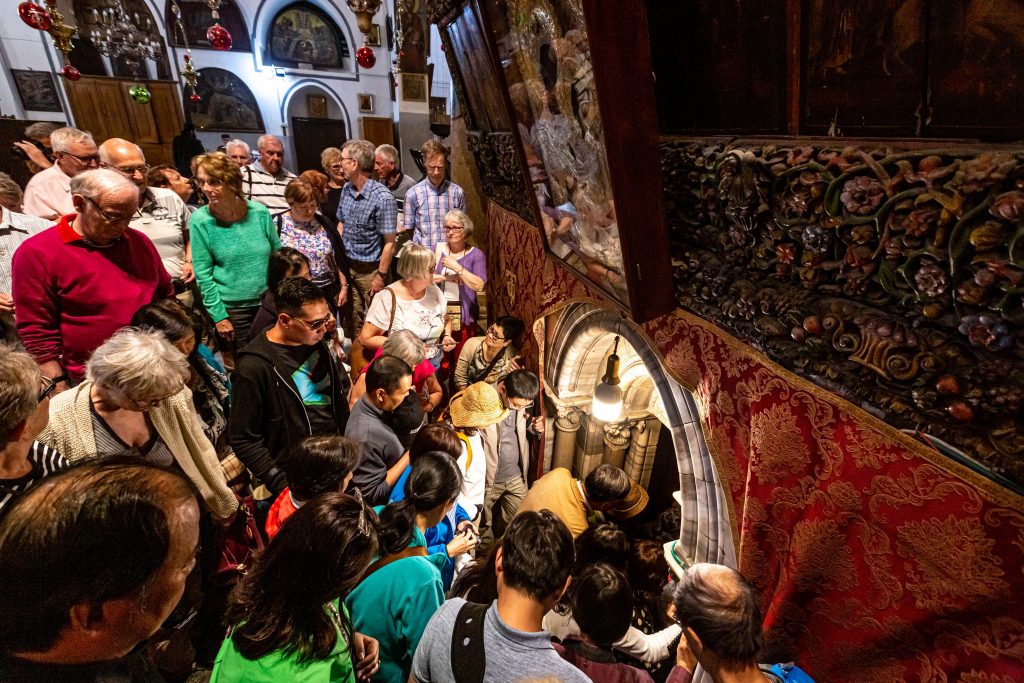At the Sea of Galilee, nearby hotels and resorts fade away. The sound of water lapping against the shore transports you to first-century Israel where you can almost hear Jesus say, not just to Peter, but also to you, “Come.”
As followers of Jesus, we live by faith. Yet these collisions with matter—ancient artifacts, largely unchanged terrain, and traditional biblical sites—shout the reality of Christ’s humanity. He was a man who lived and ministered in real villages. He traveled on real roads. For two thousand years, his life, death, and resurrection in modern-day Israel have been remembered and celebrated.
Modern-day Nazareth bares little resemblance to the small country village of Jesus’s time. Today Nazareth is the largest Arab town in fully Israeli territory.
Yet the biggest celebration among Christians revolves around something no mere man could ever accomplish. Only a God-man, only the God-Man Jesus could offer himself as a sinless sacrifice for the sins of the world, which He did in a physical place at a real point in history.
I explored some of the sites of Jesus’ life and ministry and the modern life happening around them. Several places like the Sea of Galilee are undisputed locations of Jesus’ life. Other sites are reliable places from church lore. The authenticity of yet other sites is just a mystery. Either way, walk with me through spaces once occupied by Jesus and His disciples and open your mind to the reality of Jesus’ physical life and ministry. How does this reality change our perspective, our ministry and our eagerness to share our message of hope?

Pilgrims line up to view the spot believed to be where the angel visited Mary to announce her coming son, in the Church of the Annunciation in Nazareth, Israel, the largest Christian church in all of the Middle East.
Where Mary Heard the News: Church of the Annunciation in Nazareth
One ordinary day, an angel visited a young girl and made an announcement to her that would change the world. The angel Gabriel told Mary she would conceive by the Holy Spirit and give birth to a son who would be called the Son of the Most High (Luke 2:26-35).
The Basilica of the Annunciation in Nazareth, Israel, is the largest church in the Middle East and is built over the traditional location of Mary’s house. As early as the fourth century, Christian pilgrims to Nazareth mentioned the house where Gabriel visited Mary. Multiple churches have been built on top of this location over the centuries. A visit to the modern church offers a view into a simple stone recess many believe to be the original cave-house of Gabriel’s announcement.

Christian pilgrims wait to enter the Church of the Nativity, which was built over the place where Christ is said to have been born.

A mass of Christian pilgrims waits to enter the grotto where Jesus is said to have been born, beneath the Church of the Nativity in Bethlehem, Israel.
Where Jesus Entered the World: Church of the Nativity in Bethlehem
When the Roman emperor ordered that citizens of the empire be registered, Mary and Joseph traveled from Nazareth to Joseph’s hometown, Bethlehem. It was not an easy trip. On today’s roads, it takes at least 32 hours to walk from Nazareth to Bethlehem. There, among the lowing cattle, the promised Messiah uttered His first cries.
Modern-day Bethlehem lies in the Palestinian-controlled West Bank. Although Israeli citizens are banned from entering Bethlehem, tourists are welcome. Palestine acknowledges the sacred history that beckons pilgrims from around the world and keeps the city safe and open to economy-boosting tourism.

Pilgrims look inside the grotto beneath the Church of the Nativity in Bethlehem, Israel, where it is believed Jesus was born.

Inside the grotto beneath the Church of the Nativity in Bethlehem, Israel, is a silver star that marks where it is believed that Jesus’ manger stood.
The Church of the Nativity sits over a cave that, since the second century, Christians have believed to be the location of Jesus’ birth. The Roman Emperor Hadrian was so bothered by Christians gathering there that he constructed over it a pagan worship building, which stood until Constantine’s mother, Helena, built a Christian church in the fourth century. The current church is largely a Crusader church from the sixteenth century, but it retains elements from its former structures. It is the oldest church in the Holy Land.
Tourists can enter the church only with a hired guide, who leads them through the church and into a bottlenecked crowd clamoring to descend a few stairs and see a marked location believed to be where Jesus’ manger sat.

This field outside of Bethlehem, Israel, is believed to be the place where the heavenly hosts appeared to the group of shepherds as they were watching over their flocks, to announce the birth of Jesus.
Where the World First Heard: Shepherd’s Field in Bethlehem
When the glory of the Lord shattered the darkness of a nearby field, the shepherds camping there were terrified. But the good news they heard turned their fear into joy. They hurried to see the baby and report what they witnessed.
Just a short drive from the Church of the Nativity, an unobtrusive field sits outside the city. Ancient caves still exist near the field and would have been ready shelters for shepherds. This is the field traditionally associated with the heavenly proclamation. Tourists visit a chapel on the site and sing year-round Christmas carols: “Yet in thy dark streets shineth the everlasting Light. . . .”



